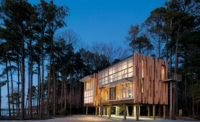Due to COVID-19 and the awakening of America to the historical and ongoing systematic oppression of Black and brown people, designers are grappling with notions of equitable practice and how to apply our skills to end the racism that is embedded in the built environment. As a society, we build what we believe in, and currently our architecture of justice in the U.S. represents beliefs in oppression, punishment, and dehumanization. Every aspect of a building has the potential to be touched by the justice system; from the labor used to manufacture what we spec to the companies that build our projects, racism is woven into how we invest in the prison-industrial complex. In the U.S., we spend approximately $80 billion per year to incarcerate, control and supervise over 6 million people, and approximately $100 billion per year goes to policing our communities. As our tax dollars fund this infrastructure, corporations, banks, and investment funds generate profit from the construction and operations of prisons and jails. By ignoring this, we are perpetuating systems rooted in slavery. So how do architects, designers, and planners help divest from systems of oppression and instead invest in the communities and people most negatively affected? What and how do we build instead?
At Designing Justice + Designing Spaces (DJDS), we ask these questions every day. We apply our creativity as designers and our capacity for collaboration to engage all stakeholders—community organizers, elected officials, affected individuals and their communities, and corrections officers—to radically reimagine a restorative-justice system that would see the end of prisons and jails altogether. Our racially diverse, multidisciplinary team and our approach focus on envisioning new systems and spaces. We identify new building typologies, partner with leaders in criminal-justice reform and prison abolition, and determine the complex funding sources to make prototype projects happen. We believe two of our current projects signal how to end mass incarceration as we know it—one in Atlanta and one in Los Angeles County.
More than a year ago, in May of 2019, Atlanta mayor Keisha Lance Bottoms passed a measure calling for the creation of a task force to provide recommendations for how to transform the city’s huge (471,000 square feet) jail downtown—originally built to house over 1,300 people but now housing only 25 individuals at any given time—into a Center for Equity and Wellness. This measure came after years of pressure from the community organizations Women on the Rise and Racial Justice Action Center. For the last year and a half, we have been working with those organizers and the mayor’s office to design and implement the community-engagement process, guide the financial and feasibility analysis, and design four creative options for repurposing the jail.
The community-engagement process was one of the most transparent and inclusive ever undertaken by the city government. We designed custom engagement games and exercises, which supported extensive dialogue between over 600 community members and the mayor’s 60-person task force. With these community stakeholders, we developed repurposing scenarios that included spaces for a healthy-food ecosystem, day care, health and wellness, legal support, and “daily needs” retail. This summer we took the results from the engagement process and designed and presented four exciting and beautiful visions for the Center of Equity and Wellness—designs we hope will guide the city in deciding what to do with the jail.
DJDS also supported Racial Justice Action Center and Women on the Rise in developing a visual survey to gather community input and preferences among the four design options, the results of which will be presented to the mayor’s office to pressure the administration to set a closing date for a decision. Early results show a preference for demolishing the existing jail and creating Centers for Equity and Wellness distributed throughout the city.
This public interest in the distributed model in Atlanta is in direct alignment with the initiatives that we are working on in Los Angeles County. There, we have been collaborating with the leaders of JusticeLA, a coalition that actively stopped a $3.5 billion plan to construct a new mental-health jail; the group coauthored what we believe is the country’s most comprehensive alternatives-to-incarceration plan to date. We are working with JusticeLA to implement the Alternatives to Incarceration plan, which was adopted by the County Board of Supervisors this past March.
For the past year we have been strategizing to bring the plan to fruition by creating a pilot project, to be used as a model process to guide capital investments. We are partnering with data-visualization, mapping, and research organizations to understand how various systems—such as health care, first response, pre-arrest diversion, housing, post-incarceration re-entry, and more—interact at the district scale. At a pilot site, we will use DJDS’s Concept Development Process as a first step toward creating a Restorative Care Village, an architectural prototype that will be part of a large distributed network of places with programming and services that put the value on care over incarceration.
These projects in Atlanta and L.A. have taught us that, as we seek to divest from the prison-industrial complex and invest in a future that is equitable, our role as creative professionals is essential. We use our unique way of thinking to bring people to the table and shake up the stagnant mindsets that too often revert to the comfort of the known. When we lead with creativity, work across disciplines, carefully listen to the community, and implement inclusive, trauma-informed methodologies, we can provide vibrant examples of how to invest to unbuild the racist infrastructure that keeps us locked in an unjust and inequitable world.






Post a comment to this article
Report Abusive Comment